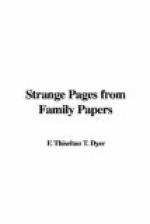Her sisters promised to accede to her dying request, but failed to do so, and her body was laid entire under the pavement of the church. Within a few days Burton Agnes Hall was disturbed by the most alarming noises, and no servant could be induced to remain in the house. In this dilemma, the two sisters remembered that they had not carried out Anne’s last wish, and, at the suggestion of the clergyman, the coffin was opened, when a strange sight was seen. The “body lay without any marks of corruption or decay; but the head was disengaged from the trunk, and appeared to be rapidly assuming the semblance of a fleshless skull.” This was reported to the two sisters, and on the vicar’s advice the skull of Anne was taken to Burton Agnes Hall, where, so long as it remained undisturbed, no ghostly noises were heard. It may be added that numerous attempts have from time to time been made to rid the hall of this skull, but without success.
Many other similar skulls are still existing in various places, and, in addition to their antiquarian interest, have attracted the sightseer, connected as they mostly are with tales of legendary romance. An amusing anecdote of a skull is told by the late Mr. Wirt Sikes.[11] It seems that on a certain day some men were drinking at an inn when one of them, to show his courage and want of superstition, affirmed that he was “afraid of no ghosts,” and dared to go to the church and fetch a skull. This he did, and after an hour or so of merrymaking over the skull, he carried it back to where he had found it; but, as he was leaving the church, “suddenly a tremendous blast like a whirlwind seized him, and so mauled him that he ever after maintained that nothing should induce him to do such a thing again.” The man was still more convinced that the ghost of the original owner of the skull had been after him, when his wife informed him that the cane which hung in his room had been beating against the wall in a dreadful manner.
Byron had his skull romance at Newstead, but in this case the skull was more orderly, and not given to those unpleasant pranks of which other skulls have seemingly been guilty. Whilst living at Newstead, a skull was one day found of large dimensions and peculiar whiteness. Concluding that it belonged to some friar who had been domesticated at Newstead—prior to the confiscation of the monasteries by Henry VIII.—Byron determined to convert it into a drinking vessel, and for this purpose dispatched it to London, where it was elegantly mounted. On its return to Newstead, he instituted a new order at the Abbey, constituting himself grand master, or abbot, of the skull. The members, twelve in number, were provided with black gowns—that of Byron, as head of the fraternity, being distinguished from the rest. A chapter was held at certain times, when the skull drinking goblet was filled with claret, and handed about amongst the gods of this consistory, whilst many a grim joke was cracked at the expense of this relic of the dead. The following lines were inscribed upon it by Byron:




